Competition is not only a fight for share in the same market, but also directly squeezes this market to give opponents a lower ceiling.
Editor’s note: This article is from “ everyone is a product manager “, Author: Yang Yibei, WeChat public account: Look around; release with authorization.
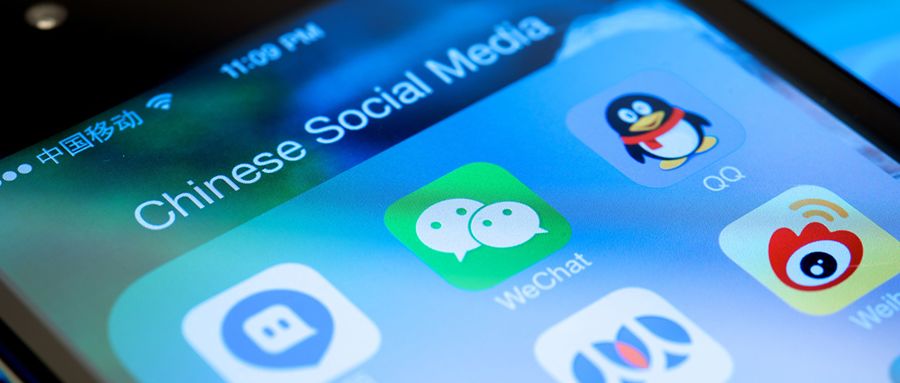
Picture creative
2019 has passed. The hottest track video in the past two years, as a popular form of video media, undoubtedly determines the direction of the content consumer industry, and even nearly disrupts the Internet landscape. Douyin quickly competed for the hegemony, and Tencent Empire strove to catch up. How does the product evolve in the post-short video era, and how does Tencent turn defeat into victory?
The exponential growth of the self-trembling sound to the billion-level DAU, Tencent launched two offensives:
The first race to make a copy of the competition was nearly wiped out by the army, leaving only a slight struggle for the slightest disregard. The second was the trial and error social circuitous interception, which is in full swing.
Restarting social products in batches is not like Tencent’s company-level strategy, but more like PCG’s tactics against Douyin. The product managers of Tencent should be determined that if there is a new content consumer product and a new Kill Time product appears, the ceiling of the natural short video will become lower.
01 User duration is a zero-sum game
204 billion hours is the monthly duration of China Mobile Internet.
At the end of October 2019, QuestMobile released the “2019 China Mobile Internet Autumn Report”: the monthly activity scale in September continued to drop to 1.133 billion, and the average daily user spend on mobile Internet is about 6 hours, and the growth rate continued to decline.
In this way, the total monthly length of the entire China Mobile Internet is about 204 billion hours, which can basically be judged to be the peak.
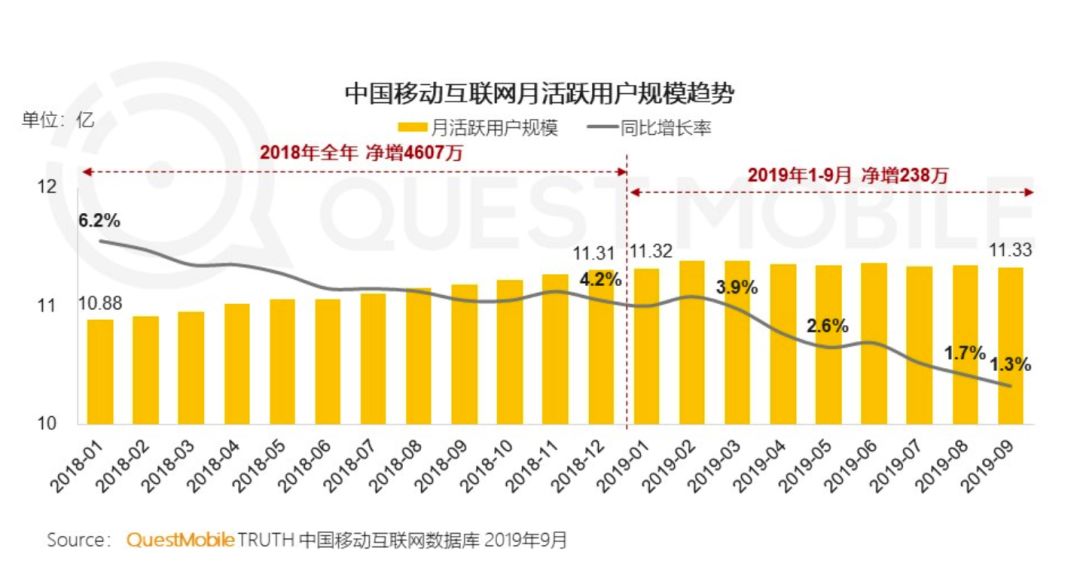
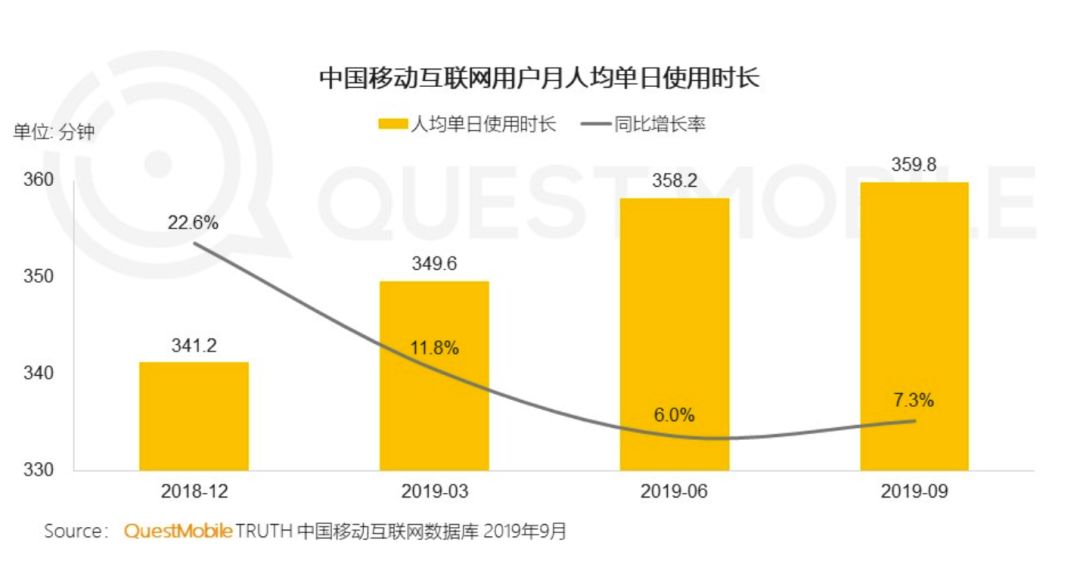
In the QuestMobile China Mobile Internet Spring Report 2019 in April, Tencent ’s user duration decreased by 3.7% year-on-year—coincidentally: the byte jump increased by 3.1%, which seems to be a metaphor for “head Teng “Middlefield”.
By June, Tencent ’s share of duration had further decreased by 1.5 percentage points, and byte bounce had increased by 0.5 percentage points. The mutual squeezing between giants continued.
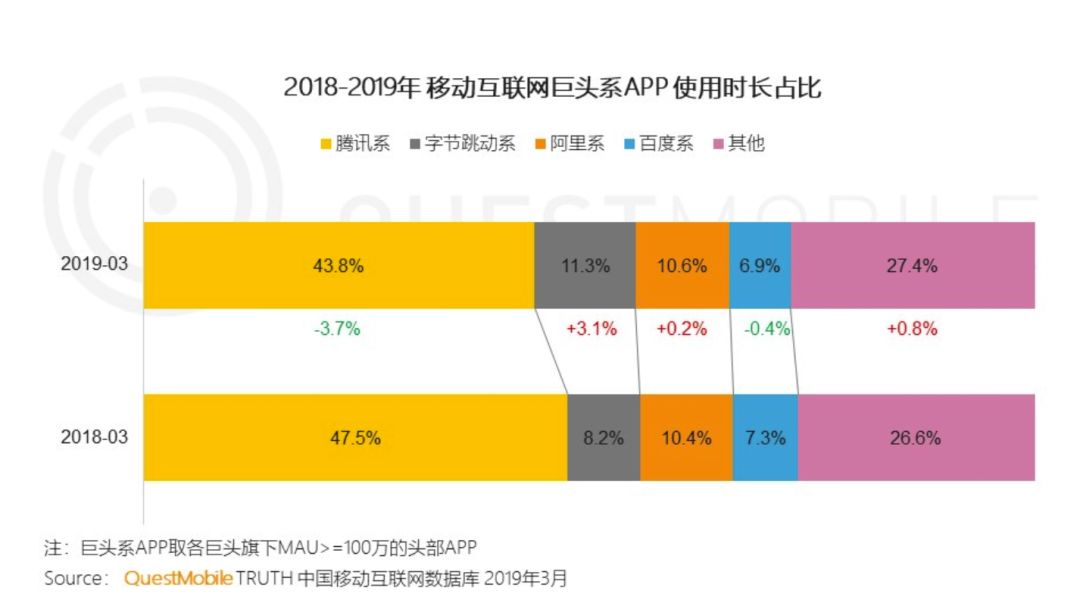
On the other hand, Douyin has just announced that it has exceeded 400 million daily livelihoods, but it can be clearly seen that the chain growth rate continues to decline.
The scale of short videos has peaked, and the short video war seems to have a fixed pattern and the end is near.
But for the pan-social entertainment track, and even for the Internet industry, the first round of competition for 2040 hours has just ended, and the length game is just warming up.
Stepping into the stock market, the duration of users is a zero-sum game in which each other’s length disappears.
02 Social-Community
Social is relationship dependent, and community is content dependent.
1. Segmentation Theorem
Many people think of socializing as a community, and the community is socializing.
In a broad sense, social and community are mutually inclusive, but in a narrow sense, the two are quite distinct.
Social is relationship dependent, and community is content dependent.
If a product is regarded as 1, X = content dependency and Y = relational dependency, then X + Y = 100%. When the relationship dependency ratio is greater than 50%, it is a social product; when the content dependency ratio is greater than 50%, it is a community product.
We use this social-community segmentation theorem to look at similar products on the Internet, and we can subdivide the positions of various product forms:

Communication tools are completely dependent on relationships, not content. The premise of communication is to establish a relationship connection. For example, a business communication tool such as Ding Ding, a colleague relationship is established by default when there is a communication behavior; p>
Social products are absolutely dependent on relationships and weakly dependent on content, such as WeChat / Momo / Tantan. The core of interaction is IM chat, which establishes connections by migrating real relationships / people nearby / flops, and the content is an interactive scene. Supplement without relying on it;
Social networks are strongly dependent on content and also strongly dependent on content. For example, Facebook / Everyone needs to establish a connection first, and then the core is to interact asynchronously through the content;
Social media is strongly dependent on content and also depends on relationships, such as Weibo. The core is “media” content production, distribution is strongly dependent on “following” relationships, and “forwarding” that spreads dependencies;
The community strongly depends on content and weak dependencies, such as Zhihu / Xiaohongshu, content production focuses on UGC, relationships are used during distribution, and new relationships are established during content consumption; < / li>
Content consumption is absolutely dependent on content and weak dependencies, such as Ai Teng, and the content supply is diverse. The core is to consume content, distribution is not dependent, and there is less relationship in the consumption scene;
Media is completely dependent on content, not on dependencies, such as headlines / portals, content production has a high percentage of PGC, and distribution and consumption are centralized; / li>
The plain text is not easy to understand. If you quantify the X content dependency and Y relationship dependency of various products, the approximate definition of each product is as follows:
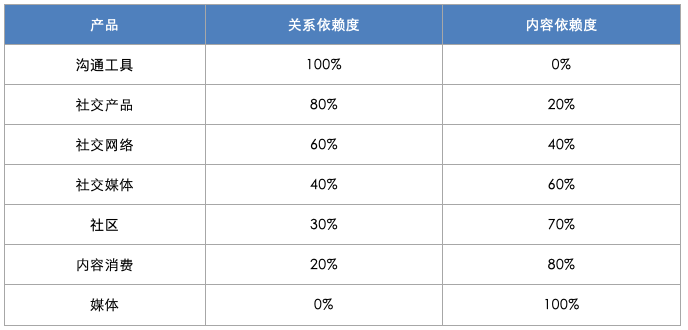
This quantitative value is based on experience and may not be accurate.
Continue to subdivide the relationship and content into strong relationship-weak relationship, strong content-weak content. Comparing the existing Internet products, you can get another quadrant map.
Not hereNow, you can draw your own.
2. Quick vibrato
Which products can Dou Dou and Kuai Shou be classified into?
Douyin is a media product that is biased towards content consumption—both like content consumer products and media products; media accounted for a high proportion, content supply focused on MCN, consistent with PGC characteristics; distribution focused on head, consistent with centralized characteristics.
To some extent, Douyin and Weibo are very similar: in the form of feed stream, consumption, unlike other media products, CTR needs to be high enough to consume.
The difference between the two is that one is based on relationship recommendations and the other is based on algorithm recommendations, so you can use Douyin as a video version of Weibo.
Fasthand is a community product that is biased towards content consumption: Faster Hand originally focused on UGC of real individuals, and the distribution is based on the principle of inclusiveness. It is an obvious community product; only fasthands began to introduce MCN on a large scale due to competition reasons, pushing the head Big V, content supply is compatible with PGC and UGC, and began to favor content consumption.
Although both rely strongly on content, Douyin’s media attributes are stronger and Kuaishou community attributes are stronger.
The stronger the relationship dependence, the easier it is to monetize by value-added services (members / rewards), and the stronger the content dependence, the easier it is to monetize by advertisements-so Douyin’s revenue is mainly advertising, and the fast hand is the live broadcast.
The vibrato relationship has a low degree of dependency, and social products have no relevance to product attributes, so multi-flash failed.
Fasthand has a stronger content dependency than Douyin, and even established a half-acquaintance relationship in the sinking market. However, Faster did not continue to explore the relationship construction, but instead turned to Douyin for content consumption.
3. Why is the content product popular now?
In the early days of the market, new additions were continuous.
Relationship-dependent products both synchronize old relationships and create new ones. New relationships focus on discovery. Most of the strangers’ social struggles can also prove this in discovering new relationships. Therefore, the incremental market is a hotbed for social relationship dependence; The volume market focuses on user scale, and competition is competition from DAU.
Relationships in the stock market tend to be stable, otaku culture encourages the development of pan-entertainment, and everyone ’s focus is on consuming content; the core of competition has become user duration, and content-dependent products have become stronger than relationship-dependent products, and even The construction of new user relationships has begun to be completed in content consumption and interaction scenarios, and the stock market is the home of content dependence.
03 Spin-off circle of friends
Refocus on a feature of the previous product and enlarge it as a whole.
—— “Lean Entrepreneurship”
From the incremental market to the stock market, the core point of competition has shifted from user scale to user duration. For Tencent, competition with Douyin is a competition of duration, which is essentially a content-dependent competition.
From the conclusion of Daily Express and WeishiFrom the point of view, Tencent, a pure content-dependent product, is more difficult to shake the byte beating (also the byte beating and multiple flashes that are purely relationship-dependent are also difficult to shake Tencent); the difficulty is that Tencent cannot take advantage of the relationship chain that has been accumulated for many years. Section Beats has pushed algorithmic recommendations to the extreme on content distribution.
From today ’s headlines to Douyin, the medium has changed and the algorithm has not changed. The conclusion is that what Tencent needs is a product that depends on both content and relationships.
Digression:
If you are interested in “subverting” Tencent, if you simply do relationship-dependent social products, the result will be the ending of intercourse / multi-flash. You must have both the relationship and the content to have the opportunity. The former Weibo may have turned to the media, and now the fast hand has the opportunity to turn to content consumption.
Products that depend on both content and relationships include communities, social media, and social networks.
The community has a tonality, it is more suitable for vertical fields, forming different circles, only small and beautiful; social media is centralized, too much focus on the head, the ceiling is obvious, Tencent has already given up the track; only social networks rely on content It can also take advantage of Tencent’s relationship chain, especially acquaintance relationships, so from the perspective of product form, Tencent should cut into content competition with social networks.
In essence, social networking is a content-based, asynchronous interactive relationship product. Both QQ space and circle of friends can be defined as social networks.
In the PC era, the QQ space that grew up on QQ was once Tencent’s largest source of revenue and defeated rivals such as 51.com;
In the era of the mobile Internet, the circle of friends on WeChat also helped Tencent win the Weibo war indirectly.
As time passes, the QQ space has been far away from the Internet center, and the circle of friends has also experienced double declines in open rate and length of stay.
WeChat has done a lot of content exploration, launched search, social recommendation, a look at community circles, and short content that will soon be launched.
It is better to go hand in hand with five fingers together, focus on the circle of friends, and use a feed stream to gather social interaction, content consumption, and media platforms-return tools to tools, and use content to drive the second curve of WeChat.

Split friends circle:
The relationship is not limited to friends, but can be extended to second-degree and multi-degree relationships to activate a wider range of social interactions;
Unify content products in WeChat, one feed stream. Integrate the content scattered in the circle of friends, subscription numbers, search and search, and look at multiple entrances;
Provide distribution platforms for other types of content and other products, such as Weishi, Kuaishou and Douyin;
Expand from the private domain to the public domain, withstand greater Ad load and increase advertising revenue;
You can explore more value-added services and expand monetization methods in product form;
From the perspective of competition, move the content consumption scenes of all categories to the circle of friends, and reduce the duration of competing products;
Of course, spin-off is accompanied by challenges:
How to distinguish from WeChat Ontology?
How to build a new relationship out of WeChat?
How can I provide user-preferred content?
How to use algorithms to separate social interaction and content consumption
And so on.
In any case, as a product of such a huge volume, WeChat still has a precedent reference. Facebook spun off Messagener when facing kik-like product competition. What will WeChat do when faced with content product squeeze?
Looking forward to changes on WeChat.